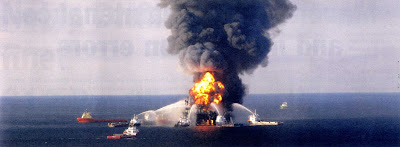British Petroleum and the Macondo Blowout; A critique of the 2014 CSB report
At a time when the Transocean Deepwater Horizon was still in the news an old comrade from my tong-swinging days told me: “They blew out their own casing, that’s why they couldn’t shut the BOPs”.
It is difficult to understand how any moderately competent drilling-rig could allow casing from below the sea-bed/wellhead/mudline to be pushed upward with sufficient force and velocity to obstruct the BOPs, which sit immediately above the wellhead. I didn’t lose too much sleep over the story but it saddened me a little that it had become more difficult for me to get the inside-story and compare it with the official truth-lite-spiel.
British Petroleum were the operators of the Deepwater Horizon in 2010 when 11 people died and a large-scale pollution incident took place.
I like to read books which is good because I have plenty of leisure time while the human-resources-scum greet about skills shortages. Greg Palast wrote Vulture’s Picnic which relates the Transocean Deepwater Horizon to the Exxon Valdez and the Azeri Central. Everyone who has been exposed to the western news media over the past few whilies has heard of the Exxon Valdez and the Deepwater Horizon. Few would have recognised the name of the Azeri Central.
Yet all three are linked by Greg Palast’s carefully researched story of the legal and financial and regulatory background. They were all the responsibility (more like the irresponsibility) of British Petroleum. The fact that you and I find it hard to relate B.P.’s kleen-green image with spectacular oil-slicks and burnt-out rigs is a tribute to the skills of the expensive public-relations-scum that B.P. employs.
Palast’s work on the Valdez, chartered to B.P., is a valuable lesson in how easy it is for an unscrupulous company to lie and cost-cut into an unnecessary disaster. Experience has shown the Bonus Pirates that when reality intrudes in their drug-scape they have an opportunity to express their contempt for regulation and regulators. They hire expensive lawyers to intimidate the politicos and expensive public relations creatures to lie to the regulators and the taxpayers who employ them. It has worked before and may well do so again.
There is no use having regulations if they are only enforced for poor people. Passing a ‘Close-the-Stable-Door Law’ after an incident is a political favourite but it only makes matters worse. If industrial regulations are to be enforced on rich and poor alike then trade unions are a necessary part of the social balance.
Greg Palast’s work on the total loss of the Azeri Central in the Caspian Sea (17th September 2008) may be of interest to those drilling-hands who find it difficult to imagine how you could blow your own casing out of the well. Surely you would get some warning?
Casing is immensely strong when pressure is applied from the inside and the outside is surrounded by cement which transmits that pressure to the drilled formation. Cased-hole is another way of saying safe-hole; hole that we have completed and sold to the operator; hole that we can rely on to help us control the uncased or open-hole at the bottom of the well. Before you can begin to push casing up the well-bore against gravity and the weight of mud you would first have to collapse it by applying pressure from the outside. This could only be possible if the cement-job was grossly defective. You could only fail to notice such gross deficiencies if you ‘saved time and money’ by not doing a cement-bond-log. That level of gross incompetence is getting close to crazy-conspiracy-theories.
Greg Palast in Vulture’s Picnic does not attempt to explain the drilling technicalities. What Mr. Palast does is link B.P.’s Macondo operation with the use of quick-setting cement. This quick-setting cement was also used on the Azeri Central. In the Caspian Sea B.P. caused the loss of the rig without actually killing anyone. The chances are we would have never known about it, even if the whole crew of 211 had died; the name of B.P. would certainly have been deleted.
If B.P. for cost-cutting reasons used sub-standard cement and failed to do a cement-bond-log, then the very brief mention of “well-debris” * in the Deepwater Horizon’s BOPs would make sense. It would have been possible for sufficient volume of gas to build-up behind the casing for a sudden catastrophic failure. The rig crew would have seen a sudden increase in the return flow-rate and would have had little chance. The BOPs are designed to close on fluids and pipes not a boat-load of steel; “well-debris”.
*CSB report/Blowout,Spring 2015,p.13
I don’t know if that is closer to the truth than the official fairytale but it seems more probable to me. I can recommend Greg Palast’s Vulture’s Picnic to anyone with a desire to know more about the Bonus Pirates.
He that tooteth not his own trumpet the same shall not be tooted
“Caspian Man said, ‘By the grace of God [Ins’Allah], the gas did not ignite so there was no explosion and no loss of life.” p.103
“Here’s the smoking, exploding gun : Central Azeri blew because BP used an ultra-risky cement that sets quickly.” p.105
“BP and its American partners concealed the dangerous blowout, and their powerful co-conspirator : the US government.” p.110
“This was the same cement mix that failed in the Gulf well, causing the Deepwater Horizon to fill with methane and blow itself to hell.” p.105
“...know your enemies ...”
Sun Tzu
Sun Tzu
© Louis Mair 2016








Comments
Post a Comment